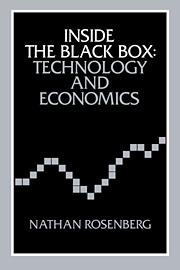Book contents
- Frontmatter
- Contents
- Preface
- Part I Views of technical progress
- Part II Some significant characteristics of technologies
- Part III Market determinants of technological innovation
- Part IV Technology transfer and leadership: the international context
- 11 The international transfer of technology: implications for the industrialized countries
- 12 U.S. technological leadership and foreign competition: De te fabula narratur?
- Index
12 - U.S. technological leadership and foreign competition: De te fabula narratur?
Published online by Cambridge University Press: 08 January 2010
- Frontmatter
- Contents
- Preface
- Part I Views of technical progress
- Part II Some significant characteristics of technologies
- Part III Market determinants of technological innovation
- Part IV Technology transfer and leadership: the international context
- 11 The international transfer of technology: implications for the industrialized countries
- 12 U.S. technological leadership and foreign competition: De te fabula narratur?
- Index
Summary
I begin with a brief deck-clearing operation, one that I hope will be noncontroversial. The discussion of America's role in international markets for high-technology products was for a long time dominated by some highly unrealistic expectations. These expectations were formed in the years immediately following World War II, when a whole generation of Americans grew up surrounded by tangible evidence of America's across-the-board technological superiority. For twenty years or so following the Second World War, and for reasons closely connected with the uneven incidence of that war and its sequelae, American technological leadership was one of the prime facts of international life. The years from 1945 to the mid- or late 1960s were, without doubt, the age of American technological hegemony.
Precisely because of their comparative technological backwardness, however, the other Organization for Economic Cooperation and Development (OECD) member countries were able to combine their recovery, not only from wartime destruction but from a longer period of neglect stretching back to World War I, with a rapid rate of technical improvement. So long as there remained a substantial gap between technology levels in the United States and the other advanced industrial countries, there was a possibility of rapid technological change through the transfer and adoption of the more sophisticated and productive American technology.
Thus, throughout the 1950s and 1960s, and with varying degrees of effectiveness, the other OECD countries played a highly successful game of technological catchup. A combination of high rates of capital formation–on the average far higher than in the United States–plus the importation and exploitation of more advanced American technologies, brought a progressive narrowing of American technological leadership vis-à-vis Europe and Japan.
- Type
- Chapter
- Information
- Inside the Black BoxTechnology and Economics, pp. 280 - 292Publisher: Cambridge University PressPrint publication year: 1983



